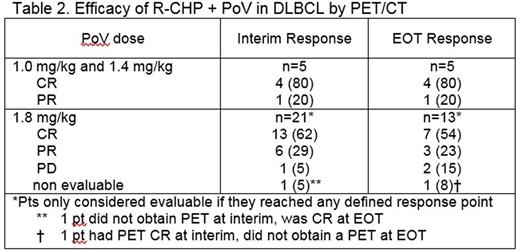Abstract
Introduction: Previously reported results from an ongoing study of polatuzumab vedotin (PoV), an antibody drug conjugate (ADC) containing the anti-mitotic MMAE targeting CD79b, in combination with rituximab, cyclophosphamide, doxorubicin, and prednisone (R-CHP) demonstrated an acceptable safety profile in patients (pts) with previously untreated DLBCL. The dose escalation (esc) phase established a recommended phase 2 dose of PoV at 1.8 mg/kg. We report updated safety and efficacy results for this multicenter, open-label Phase Ib/II study of PoV combined with R-CHP in previously untreated DLBCL pts (ClinicalTrials.gov NCT01992653).
Methods: In the esc phase of this study, pts aged 60-80 years, with newly diagnosed or relapsed/refractory B-cell NHL were given PoV intravenously 1.0, 1.4, or 1.8 mg/kg with R-CHP every 21 days for a total of 6 or 8 cycles. In the dose expansion (exp) phase, pts were restricted to those with previously untreated DLBCL and aged 18-80 years. Investigator assessments for anti-tumor activity by Cheson 2007 were performed following 4 cycles of study treatment (tx) and at the end of study tx (EOT).
Patients: DLBCL patient characteristics as of February 5, 2016 are included in Table 1. The majority of the subjects were IPI 4-5.
Results: Of the 36 safety evaluable pts, the most common adverse events (AEs) in > 20% of pts were fatigue (36%) and diarrhea (30%), nausea (31%), and neutropenia (25%). 44% had at least one Gr 3/4 AE including neutropenia (22%), febrile neutropenia (14%), hypertension (8%), thrombocytopenia (4%), leukopenia (4%), oral fungal infection (4%), dysphagia (4%), vomiting (4%), asthenia (4%), fatigue (4), decreased appetite (4%), hyponatremia (4%), malnutrition (4%), chylothorax (4%), back pain (4%), motor dysfunction (4%), and confusional state (4%).
Serious AEs were reported in 33% of pts, with 17 different events. These included 4 episodes of febrile neutropenia, 2 of neutropenia, 2 of pneumonia, and 1 each of E. coli UTI, oral fungal infection, hyponatremia, malnutrition, chylothorax, pulmonary embolism, pyrexia, pathologic femur fracture, and worsening of rheumatoid arthritis. 33% of pts experienced peripheral neuropathy (PN). The reported terms included PN, paresthesia, muscular weakness, neuralgia, and motor dysfunction. All neurologic AEs attributed to PoV were Gr 1 except one PN that was Gr 2 and improved to Gr 1 after PoV dose reduction. There were 2 pts that discontinued study treatment due to AEs (one with a Gr 2 tremor who is still in CR, and the other with Gr 2 UTI who ultimately progressed) while 5 (14%) had PoV dose reductions (2 PN, 2 neutropenia, 1 weight decrease and asthenia). No Gr 5 AEs were reported among the exp cohort.
At the time of this report, response assessments were available in 26 pts. All pts in the esc phase have completed study tx and 8 in exp cohort have completed study tx. Interim and EOT PET response is summarized in Table 2. Among the 2 pts that developed progressive disease in the exp phase, one pt had a new axillary lesion and subsequently died despite salvage tx; the other patient had a CR at interim evaluation, but stopped all tx after 5 cycles due to E. coli UTI and subsequently developed recurrent disease.
Conclusions: Early results show that PoV plus R-CHP has an acceptable safety profile in pts with previously untreated DLBCL. Although the protocol-specified MTD was not formally reached, the recommended phase 2 dose of PoV was established at 1.8 mg/kg based on the overall safety and tolerability profile at that dose. The pts treated at the phase 2 dosing were strongly weighted in the high risk category by IPI and in that context, efficacy is promising and will be updated at the time of presentation.
Morschhauser:Janssen: Honoraria; Roche: Consultancy, Honoraria; Celgene: Consultancy, Honoraria; Gilead Sciences: Consultancy, Honoraria; Servier: Consultancy, Honoraria. Bartlett:Gilead: Consultancy. Sharman:Gilead: Research Funding; Seattle Genetics: Research Funding; Celgene: Research Funding; Pharmacyclics: Research Funding; Acerta: Research Funding; TG Therapeutics: Research Funding. Haioun:Janssen: Honoraria, Membership on an entity's Board of Directors or advisory committees; Gilead: Honoraria, Membership on an entity's Board of Directors or advisory committees; Sandoz: Honoraria, Membership on an entity's Board of Directors or advisory committees; Celgene: Honoraria, Membership on an entity's Board of Directors or advisory committees; Roche: Honoraria, Membership on an entity's Board of Directors or advisory committees. Kolibaba:Celgene: Research Funding; Acerta: Research Funding; Janssen: Research Funding; Amgen: Research Funding; Cell Therapeutics: Research Funding; GSK: Research Funding; Novartis: Research Funding; Gilead: Consultancy, Research Funding; Genentech: Research Funding; Pharmcyclics: Research Funding; Seattle Genetics: Research Funding; TG Therapeutics: Honoraria, Research Funding. Chen:Seattle Genetics: Consultancy. Jones:Genentech, Inc.: Employment. Penuel:Genentech/Roche: Employment. Lee:Genentech, Inc.: Employment. Salles:Gilead: Honoraria, Research Funding; Celgene: Consultancy, Honoraria; Janssen: Consultancy, Honoraria; Mundipharma: Honoraria; Novartis: Consultancy, Honoraria; Amgen: Consultancy, Honoraria; Roche/Genentech: Consultancy, Honoraria, Research Funding.
Author notes
Asterisk with author names denotes non-ASH members.



This feature is available to Subscribers Only
Sign In or Create an Account Close Modal